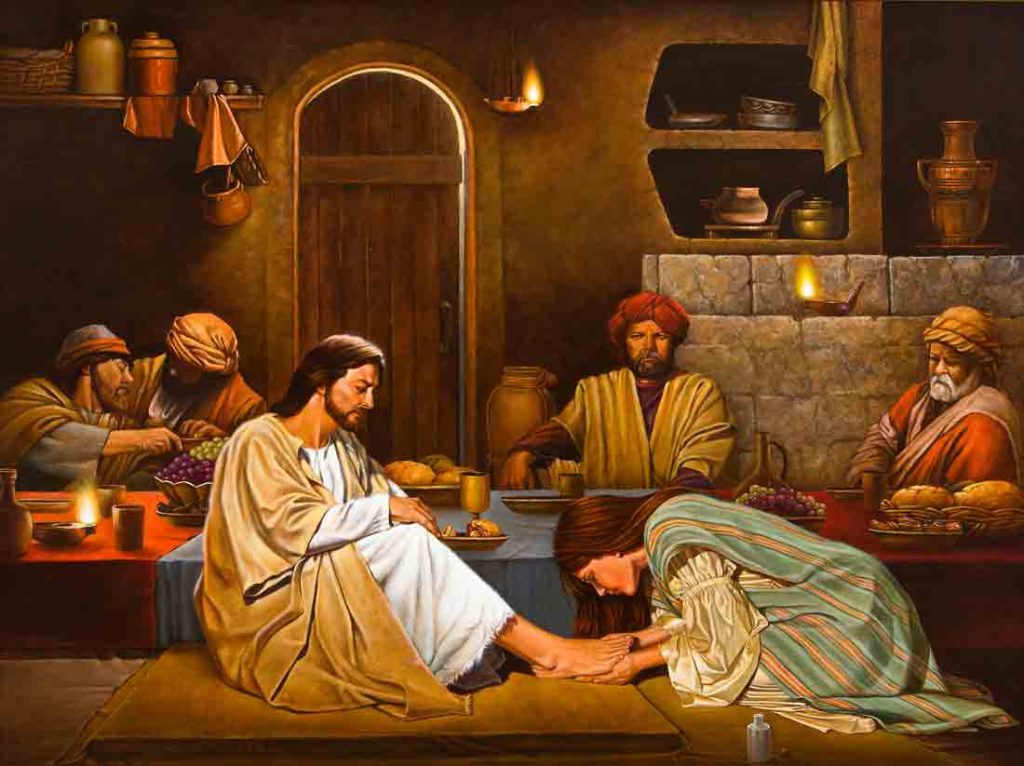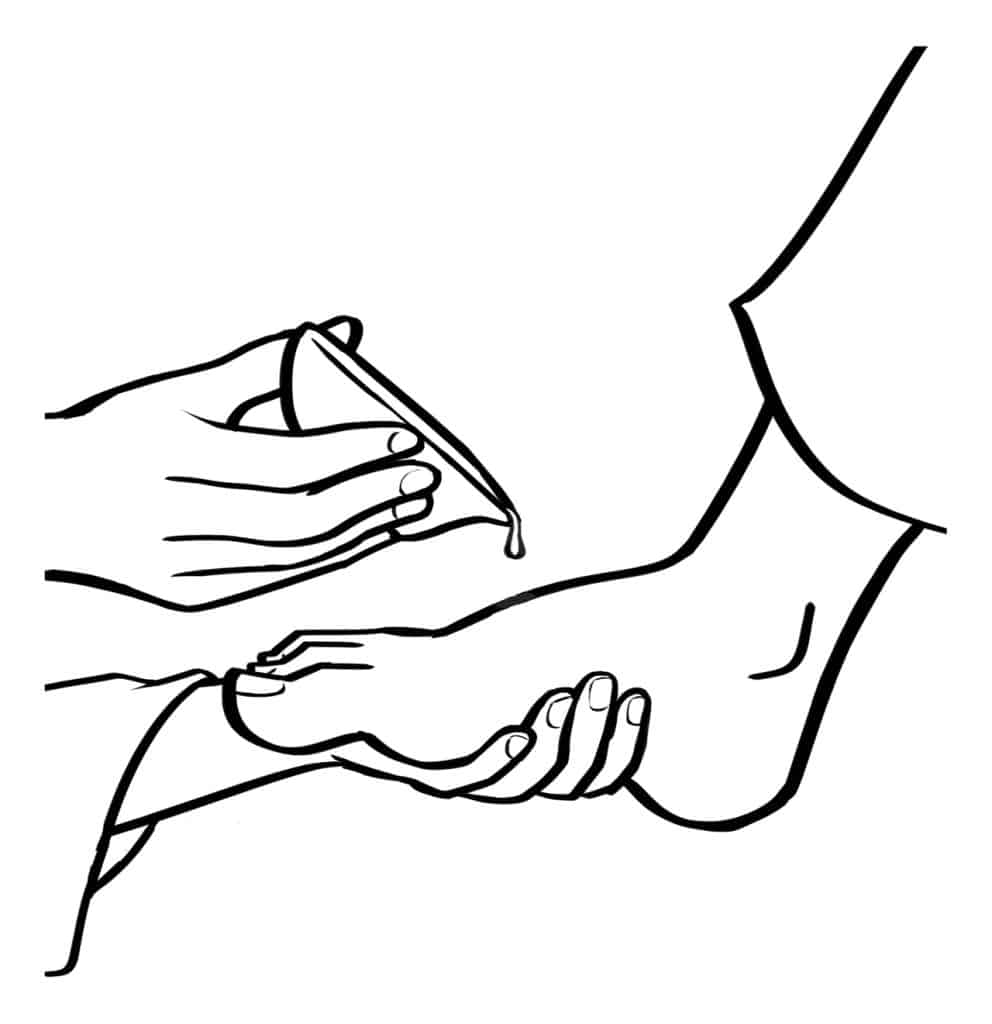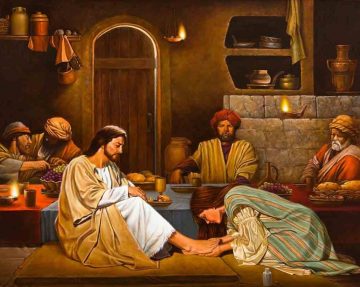I’ve broken today’s lesson into two main parts: “The Woman Who Anointed Jesus” and “The Last Supper.” I plan to use this lesson plan for guiding my own family scripture study. Therefore, I’ve broken things up into very small chunks where we can just focus on one part of the stories as we read them. For example, we’ll likely focus on each of the 4 themes I listed under “The Woman Who Anointed Jesus” on 4 separate days. If you are using this plan for a lesson at church, just pick and choose what makes sense for your class.

The Woman Who Anointed Jesus
Let’s start off focusing on the story of the woman with the ointment who anointed Jesus with it. If you’re doing this for a lesson at church, you may choose to spend a lot of your time on this story (as there’s really a lot to unpack and discuss as you see below). If you are doing it for home/personal study, I recommend reading the account in Matthew and then spending a different day on each of the themes I outlined below the story).
There are a couple slightly different versions of this story in the various gospels, but here I’ll copy/paste Matthew’s account:
Matthew 26:
6 Now when Jesus was in Bethany, in the house of Simon the leper,
7 There came unto him a woman having an alabaster box of very precious ointment, and poured it on his head, as he sat at meat.
8 But when his disciples saw it, they had indignation, saying, To what purpose is this waste?
9 For this ointment might have been sold for much, and given to the poor.
10 When Jesus understood it, he said unto them, Why trouble ye the woman? for she hath wrought a good work upon me.
11 For ye have the poor always with you; but me ye have not always.
12 For in that she hath poured this ointment on my body, she did it for my burial.
13 Verily I say unto you, Wheresoever this gospel shall be preached in the whole world, there shall also this, that this woman hath done, be told for a memorial of her.
There are so many themes to discuss and learn from and unpack here. Let’s break some of them down:
Theme 1: The Woman
At a time in history when women’s stories were largely undervalued/unwritten, the writers of the gospels felt it necessary to talk about the anointing that this woman performed. Pastor and blogger Charlotte Vaughan Coyle wrote of the faith of this woman (and other women in the gospels who did similar acts) as follows:
These women in our story are poor and yet their gift to Jesus is an opulent gesture.
Conventional wisdom labels it “wasteful,” foolish, senseless. But in God’s economy, abundant amazing grace is never wasteful.
The women pour out their anointing with reckless abandon.
They sanctify the moment with their lavish love.
They honor Jesus with their bold extravagance.
It is the giving that creates the grace.
It is the giving to which we are called.
We don’t control how the gift is received.
We can’t know how the gift will be used.
We mustn’t presume to judge worthiness.
We simply are called to give. To offer grace in abundance.
As God does.
Discuss the following questions as a class, family, or ponder individually:
- 1. What stands out about the faith of this woman?
- 2. How might we learn to answer the “call to give?”
- 3. What is “abundant amazing grace?”
- 4. How can we offer “grace in abundance” to those around us?
Theme 2: The Poor
Wendy McMahan (of the organization “Food for the Hungry”) discussed the controversial interpretations of the statement “ye have the poor always with you.” She said, “Sometimes this verse is interpreted as if to say, ‘You can’t overcome poverty. It’s a useless cause. Don’t waste your money on it. Even Jesus said so’.” But then she elaborated on how this viewpoint is really not correct or even in line with the scriptural context. Specifically, it’s taking this quote out of context (where it clearly is referring to the tangible death of Christ the next day), it is ignoring that Christ was quoting ancient scripture (where Moses wrote God’s command to always give open-handedly to the poor among them), and it ignores who the Savior was talking with (Judas Iscariot). Therefore, “The woman who anointed Jesus is still teaching us today, just as Jesus predicted. Her example challenges us to give our very best to God, without regard to the way others might see us.”
Discuss the following questions as a class, family, or ponder individually:
- 1. When is it difficult to give our best to God?
- 2. How might we respond when others criticize the way we serve God?
- 3. How might we learn, personally, how God wants us to serve Him?
- 4. How might we refrain from negatively judging others if they serve God in ways that we may not see fit for ourselves personally?
Theme 3: The Apostle’s Indignation
In the same article cited above, Wendy McMahan wrote:
We know from John’s account of this scene that Judas Iscariot was the disciple who questioned why the perfume was not sold and the proceeds given to the poor.
Immediately after this scene, Judas would leave to betray Jesus. Judas was trying to find cause for criticism of Jesus, and to distract from a lavish act of love to the Savior. Jesus was correcting the idea that any act of love for Jesus is ever wasted. He even called it “a beautiful thing!” When we follow the many commands of Scripture to care for those in poverty, develop relationships with them, and lavish our time on serving others, might He also call these acts “a beautiful thing”?
Discuss the following questions as a class, family, or ponder individually:
- 1. Judas Iscariat was looking for reasons to criticize rather than being full of humility and charity. Do we ever do that personally? How can we avoid that?
- 2. What acts of love can we currently do for the Savior?
- 3. How can we see the beauty in the acts of love that others do for the Savior?
Theme 4: Christ and the Woman Preparing for His Burial
I want to draw a little bit of attention to verse 12, “For in that she hath poured this ointment on my body, she did it for my burial.” Clearly, He wouldn’t need the ointment before His death – that was a ritual that would typically take place on the dead body. However, He knew that His death was crucial to the salvation of everyone. And the woman had the faith to believe the same. He wanted to give her the opportunity to perform this ritual because He knew it was important to her and an opportunity for her to show her love and gratitude for the greatest gift she had ever been given. It really is a testament of her faith and His willingness to help her live her faith in a symbolic way.
Discuss the following questions as a class, family, or ponder individually:
- 1. There are a lot of things that we do that symbolically show our faith. What are some of these things? How do they help empower you? How do they help you show gratitude? How do they help you live more fully?
- 2. Can the symbolic gestures we perform ever become more important to us than our relationship with the Savior and truly being His disciple? If so, how can we avoid that? How can we make sure that our symbolic rituals help us to feel empowered/show gratitude/live more full of faith?
Bonus theme: What other impressions/themes did you notice while reading this passage? I’d love to hear, so please make note in the comments if you have something else to ponder with these versus.

The Last Supper
One of the symbolic rituals we perform each week is the Sacrament – which stems from the Last Supper. Let’s focus on the importance of this symbolism. First, the scriptures telling the story off the Last Supper:
Matthew 26:
26 And as they were eating, Jesus took bread, and blessed it, and brake it, and gave it to the disciples, and said, Take, eat; this is my body.
27 And he took the cup, and gave thanks, and gave it to them, saying, Drink ye all of it;
28 For this is my blood of the new testament, which is shed for many for the remission of sins.
29 But I say unto you, I will not drink henceforth of this fruit of the vine, until that day when I drink it new with you in my Father’s kingdom.
The Sacrament is a ritual that is meant to help us remember our relationship with the Savior (or covenants that we’ve made). Sister Linda K. Burton, General Relief Society President, said, “Covenant keeping strengthens, empowers, and protects…As we keep our covenants, we also receive courage and strength to help us bear one another’s burdens.”
Discuss the following questions as a class, family, or ponder individually:
- 1. What does taking the Sacrament mean to you personally?
- 2. How does covenant keeping strengthen us?
- 3. How does covenant keeping empower us?
- 4. How does covenant keeping protect us?
- 5. How might we be given courage and strength to help us bear another’s burdens?

In case you’re teaching little ones, use this coloring page
*All images courtesy of the Church of Jesus Christ of Latter-Day Saints media library: https://www.churchofjesuschrist.org/media?lang=eng.






3 Responses
Thank you Miriam!! Excited to use some of your content in my SS class Sunday. The Church guide for the class doesn’t even mention the woman so your questions and commentary are so helpful.
So glad it’ll be useful!
I love the Wendy McMahan quote you included. I think that verse is often misinterpreted or misused.